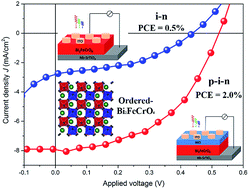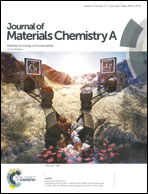Multiferroic Bi2FeCrO6 based p–i–n heterojunction photovoltaic devices†
Abstract
Photovoltaic devices made of ferroelectric films are being widely studied, due to their efficient charge separation driven by the internal polarization as well as above-bandgap generated photovoltages. These features may enable power conversion efficiencies (PCE) exceeding the Shockley–Queisser limit, which characterizes conventional semiconductor-based solar cells. However, improving the PCE of such devices is still a challenge, mainly due to the weak charge transport and collection induced by the recombination of photocarriers. Here, we fabricated p–i–n heterojunction devices based on double-perovskite multiferroic Bi2FeCrO6 thin films. The latter act as intrinsic absorbers, sandwiched between hole- and electron-transporting layers, a p-type NiO and an n-type Nb-doped SrTiO3 semiconductor, respectively. Under 1 sun illumination, the optimized p–i–n device yields an open-circuit voltage of 0.53 V and a short-circuit current density of 8.0 mA cm−2, leading to a PCE of ca. 2.0%, a four-fold enhancement compared to that of the i–n device architecture.

- This article is part of the themed collection: CSC100: Celebrating Canadian Chemistry


 Please wait while we load your content...
Please wait while we load your content...